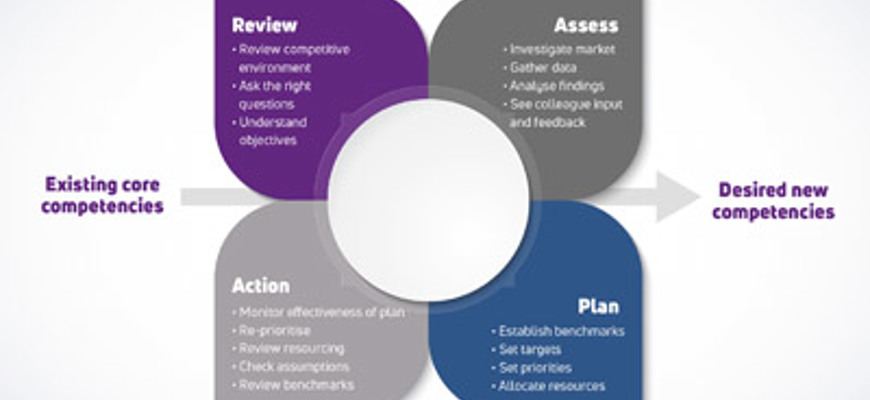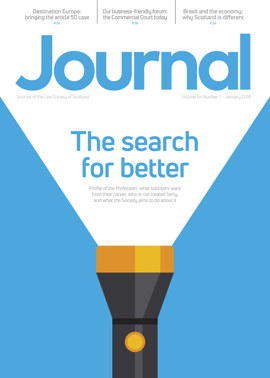Navigating competencies

Core competencies
Competencies in this context cover areas of practice/legal specialism as well as particular competencies within those specialist areas. Contrast these with individual competencies such as analytical ability, communication skills and project planning. These latter competencies will always be essential regardless of the area of practice.
For some practices, the process of identifying their core competencies is a quick one: “Here is a list of work we do as a practice and anything not on that list, we will refuse to undertake.” For many more firms, in the real world, it is often not so straightforward. Last month’s article gave an insight into how drifting away from core competencies can happen in practice and how easy it is to start “dabbling”.
Understanding and monitoring firm competencies
It may be easy for an individual to have an understanding of their own competencies and limitations. However, the firm’s competencies are the collection of the competencies of all of its staff and the whole may be well be greater than the sum of its parts.
It can be difficult for a firm to recognise, communicate and monitor its collective core competencies. A firm needs to draw together the individual competencies of its solicitors, paralegals and support staff and develop a picture of “firm core competencies”. That may not necessarily be as easy to achieve as simply listing generic practice areas and assigning roles to individuals based on those categories.
Even in smaller firms, it is not always easy to stay on top of this as competencies develop. A firm may not realise that a team or an individual has developed a particular skillset. Skillsets are continuously evolving through:
(a) dealing with a series of similar or related matters which develop existing competencies;
(b) additional training;
(c) research on new areas of expertise;
(d) new individuals with their own particular competencies joining the firm.
Failing to tap into that knowledge can mean that a firm could be declining work which could comfortably sit within the firm’s acceptable risk profile.
At a practical level, a deficient understanding of a firm’s competencies can lead to opportunities being missed. Take the example where commercial partner B declines a transaction focused on incentivising employees through the use of share option schemes, in which B has limited experience. However, B is unaware of the background of solicitor D (who has extensive and current experience of such transactions from a previous firm).
Conversely, skillsets can become outdated or lost, through lack of exposure to particular matters, failure to invest in or update training, changes in the law, shifts in client profiles leading to less familiarity with particular sectors, or staff loss.
A firm has to take care that work is not being undertaken because it falls into a generic category, where the individuals working on that matter lack the specific competencies for that particular piece of work. For instance, if a firm which undertakes commercial work advises on specialist intellectual property licensing and protection, does that comfortably fit with that firm’s risk appetite? It may do, as the individual dealing with the matter may have a particular expertise. If, however, the individual has limited experience of IP matters, is the task something which the firm ought to have accepted?
One of the ways in which a firm can assess its core competencies is by undertaking a periodic audit to establish current competencies and training needs. That not only serves to establish the current position but whether there is any:
(a) need for additional training;
(b) scope for developing new competencies; and/or
(c) requirement for better communicating competencies internally.
Development or diversification?
There is no such thing as the status quo. Effective and regular CPD is an essential part of professional standards. Practices of all sizes have to adapt as the law evolves. Solicitors need to keep up to date with changes in the existing areas of law in which they practise. Professional development will therefore always be part of any firm’s strategy.
The key question is whether it is worth expanding the firm into new areas of practice in order to widen the service offering. It is important for firms to differentiate between an expansion strategy and “dabbling”. The two are not the same.
The difficulties for practices result from failing to assess and address the potential adverse risks when expanding their core service offering. Practices ought not to be afraid of developing new competencies, provided the reasons for this are clear and the process is well managed.
Assessing and managing risks when expanding core competencies will help
prevent claims.
Safely navigating from core to new
The key to developing new competencies while minimising the risks of adverse impact for any practice is to develop these new skills in accordance with a structured plan. While there may be no need to embark on a detailed business planning exercise, there is merit in answering some basic questions such as:
(a) What areas of legal practice do we have a strong competency in?
(b) Are these sufficient for our future requirements (in terms of growth, profitability or other benchmarks)?
(c) If not, how should we diversify or expand the areas of practice in which we operate?
(d) How are we going to achieve this?
(e) Do we need a plan?
Figure 1 outlines a competency development model. The steps are reviewed below.
Review. This should look at the business environment in which the practice is operating now, and future predictions. This identifies development needs and informs decisions around whether expansion of competencies is desirable or necessary. The review stage also involves a practice asking itself some searching questions. These could be related to future profit or growth targets; the possibility of losing market share to competitors; diminishing returns in a particular area of specialism; or the need to broaden the practice’s service offering to avoid downturns in a particular sector.
Assess. Following the review stage, the practice then requires to undertake some research by investigating the market for new services (i.e. the services that will be facilitated by the desired new competencies). Also, in addition to data gathering the firm should seek input – either from an external mentor or from colleagues in relation to the proposed plan
and the changes that may be required to implement this.
Plan. If, after the assessment stage, the practice is still of the view that there is merit in pursuing the development of new competencies, a plan of action is required. That involves setting priorities and objectives and requires consideration of resources. Without effective resourcing, desired targets will not be met. Resources could involve investment in new technology/knowledge management; and additional staff and/or external training for existing staff.
Action. In order to achieve a successful change and effectively develop new competencies, success should be measured.
Summary
How a practice goes about reviewing and understanding its competencies will vary – for some, this will be a relatively easy process. Some practices will develop new competencies in a straightforward manner in response to business necessity. Others may have to consider carefully whether the additional investment in new competencies is necessary or desirable.
Whether a structured or informal approach is taken, the key issue is that a firm needs to be aware of the risks in order to steer a safe course. Without thinking about a journey from one core competency to another, a practice could easily find itself at the outer limits of its comfort zone and perilously close (perhaps inadvertently) to undertaking non-core activities with all the attendant risks.
Gail Cook is a client executive within Lockton’s Master Policy team. She has 30 years’ experience in the field of professions underwriting and risk management and is the main Lockton contact for risk management matters. She can be reached on 0131 345 5571 or gail.cook@uk.lockton.com
In this issue
- Brexit: prepare for impact
- Continuity and compatibility
- The Disability Convention: clearing obstructions
- Policing review: the priorities
- Five investment practicalities for lawyers managing trusts
- Reading for pleasure
- Opinion: Aamer Anwar
- Book reviews
- Profile: Serena Sutherland
- President's column
- People on the move
- Lifting the lid on the law
- The article 50 case: how it happened
- Forum for business
- Relevant persons: an alternative
- Three ways to enhance digital innovation
- Brexit north of the border
- Roberton – a way forward?
- Interest that runs for years
- Minimum pricing: what next?
- A bill not as planned
- Consumer contracts, choice of law and time bar
- Entrepreneurs' relief: tightened too far?
- Scottish Solicitors' Discipline Tribunal
- In the name of justice
- Views from the bar
- Design the Journal front cover!
- Public policy highlights
- OPG update
- Police station interview training – an update
- Easier caution with Marsh online service
- Fantastic locums – and where to find them!
- Navigating competencies
- C1s – why they bounce
- Conference content?
- Turn on the black box
- Ask Ash






